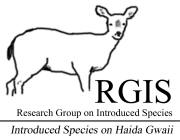

- Menu
- Home
- Haida Gwaii
- Introduced Species
- RGIS
- What did we learn?
- Research
- Publications
- RGIS symposium
- School curriculum
- Contacts
- English
- Français
Publications - Plant ecology |
|
|
Diego P. Vazquez, Julie Gresser, Jean-Louis Martin,
2010,
Introduced deer and the pollination and
reproduction of an animal-pollinated herb,
Botany
88:
110–118 (2010)
- PDF
Abstract: We evaluated the hypothesis that the modified population density of Aquilegia formosa Fisch. ex DC. (Ranunculaceae) resulting from the introduction of Sitka black-tailed deer (Odocoileus hemionus sitkensis) in the Haida Gwaii archipelago affects the pollination and reproductive performance of this herbaceous species. We compared the population density, pollination, and reproductive success of A. formosa among three small islands colonized by deer and three deerfree islands. Islands with deer had a substantially lower absolute density and a greater relative density of A. formosa than deer-free islands. The presence of deer was associated with higher pollen deposition, which probably resulted from the greater relative density of A. formosa on islands with deer. However, the presence of deer had no significant effect on individual reproductive success. The latter result is likely a consequence of the lack of pollen limitation in this species, as well as of the conflicting relationship between the absolute and relative densities of A. formosa and the presence of deer.
Noemie Stroh, Christophe Baltzinger, Jean-Louis Martin, 2008,
Deer prevent western redcedar (Thuya plicata) regeneration in
old-growth forests of Haida Gwaii: Is there a potential for
recovery?,
Forest Ecology and Management 255 (2008) 3973–3979
- PDF
Abstract
: The current increase in deer populations in many forests has
fostered a growing concern about their impact on forest ecology.
Sitka black-tailed deer (Odocoileus hemionus sitchensis) were
introduced to Haida Gwaii (British Columbia, Canada) in the late
19th century, and they have dramatically affected the regeneration
of woody species in both old- and second-growth forests since then.
The lack of recruitment in western redcedar (Thuja plicata) in
old-growth forests has been attributed to deer. The objectives of
this study were to (1) experimentally confirm that deer browsing
causes a lack of western redcedar recruitment and (2) assess the
potential for and speed of recovery after a prolonged exclusion of
deer.We installed a set of 20 enclosures and monitored them over a
period of 8 years from 1997 to 2005. We compared temporal changes in
redcedar cover and in the survival and growth of marked seedlings in
plots that were or were not accessible to deer. Redcedar cover in
the vegetation layer accessible to deer was generally low (from 3 to
5%) but higher inside the enclosures (an average difference of
2.3%). Protected seedlings survived better, were higher, presented
more leafed shoots, and had less stems than unprotected individuals,
features that suggest that deer were key to the lack of
regeneration. However, growth was very slow (protected marked
seedlings grew 2.5 cm on average in 8 years) and, under the current
conditions, the time required for a protected seedling to escape
deer would probably take over two decades. This very slow growth
rate under closed canopy conditions probably reflects a gap-phase
regeneration strategy and/or sensitivity to competition with other
woody species. The combination of a very slow growth with a high
palatability and a lack of physical defences, in contrast to the
other dominant conifers in this ecosystem, probably explain why
redcedar regeneration can be eliminated from old-growth forest by
abundant deer populations. |
|
|
Stephen A. Stockton, Sylvain Allombert, Anthony J. Gaston, Jean-Louis Martin, 2005, A natural experiment on the effects of high deer densities on the native flora of coastal temperate rain forests, Biological Conservation 126 (2005) 118–128 – PDF Abstract: The introduction of |
|
|
Christophe Baltzinger, Jean-Louis Martin, 2002, Interactions among deer browsing, hunting and tree regeneration, Abstract: The intentional removal or addition of species or specific human impacts on ecosystems trigger changes that can help us understand species interactions. In many temperate forests, deer populations are increasing and so is the need to understand how they influence ecosystems. We took advantage of the introduction of |
|
|
|
|
| return to top of page | |